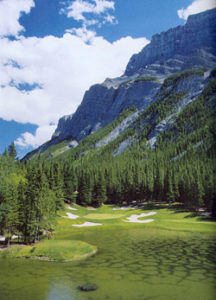Les Furber, ASGCA of Golf Design Services, restored the course at Banff Springs Golf Resort in Canada’s Banff National Park, elevating its playing conditions and enhancing the golf experience while protecting and preserving the environment. Located in a valley below Sulfur Mountain and Mount Rundle, the complex consists of 27 holes, with the original 18 holes-designed by Stanley Thompson in 1928-winding along the Bow River and playing to a par 72 at 7,083 yards.

Banff Springs Golf Resort in Canada
After being in operation for more than 60 years, the course was in need of a refurbishing. Due to the course’s location in a national park, Furber worked with the Department of Parks Canada to incorporate findings from an Environmental Impact Assessment in the planning and construction process. Large areas of the property were to be left to revert back to a native state, creating a better habitat for wildlife.
The overall intent for the refurbishment was to maintain all original green contours, though some tees were rebuilt and bunkers relocated. For the greens construction, the plan was to core out the cavity, install drainage, and rebuild with USGA approved greens mix, using the excavated material in other areas.
The Environmental Impact Assessment, however, showed alarmingly high rates of mercury contamination in the green complexes, due to the use of preventative fungicides prior to 1970. Furber was told that disturbing the soils could mobilize the mercury, so the soils would need to be disposed of at a controlled landfill, at a cost of more than a half million dollars, with numerous public hearings and mitigation studies required and a two to five year timeframe.
Rather than excavate the cavities, Furber and his team decided to reconstruct the greens above the original contours. A network of flat pipe drainage was laid on the existing turf grass putting surface, covered with 6″ of drainage rock and 12″ of the greens mix, building a new green surface 18″ above the original putting surface. Fill material elevated the surrounds to maintain the original appearance.
With the continuous supervision of the golf course architect and on-site meetings with the golf course staff throughout the construction process, Les Furber Design was able to undertake a project that was successfully completed and enthusiastically endorsed by the Canadian National Parks Department.
